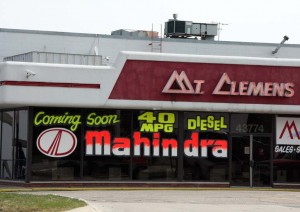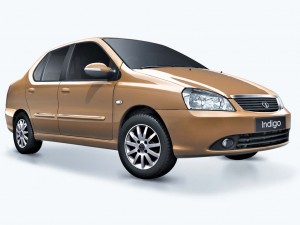
This former Chrysler dealership, in the Detroit suburb of Mt. Clemens, will soon become one of the first American retailers to handle India's Mahindra.
For decades, the suburban Detroit showroom was a popular place, but when Chrysler decided to slash its dealer count as part of its bankruptcy reorganization, Mt. Clemens Dodge was one of the first to go. No problem, however, as almost overnight, a new banner popped up in the sprawling retailer’s plate glass window.
In the coming months, the Mt. Clemens outlet will become the first in the Motor City to start selling the new Mahindra Pik-Up which, in turn, will mark the first time an Indian-made automobile will reach the U.S. market.
Eventually, Mahindra will add a sport-utility vehicle to its American line-up. (Click here for TheDetroitBureau.com’s review of both models.) And there’s a reasonable chance Mahindra eventually will be joined in the States by its chief home market rival, Tata Motors.
But plans have a way of changing, and with the U.S. mired in an economic downturn, and little likelihood that the car market will recover from its worst slump in half a century, foreign makers, in general, are rethinking their plans. For the Indians, in particular, analysts say, it’s leading them to make a more concerted push to build up their own market, on the subcontinent, with makers like Mahindra and Tata looking for guidance to what has happened in China.

Tata Motors is betting it can draw from the emerging Indian middle class with the midsize Indigo Manza.
The Chinese market, this year, surged past the States and is now the world’s largest national passenger car market – something most analysts didn’t expect to happen for another decade or more. The U.S. could regain that ground as it recovers, but the huge boom in China is nonetheless impressive and reflects what can happen when government policy favors the auto market.
The current administration, which recently won a solid victory, is shifting to freer market strategies. And it’s expanding previous policies of building new roads and freeways. That, says Patrick Marinoff, a Daimler AG executive, “is one of the biggest problems” India faces if it hopes to nurture the auto industry. Much of the country is still unreachable by anything other than foot or donkey cart.
Though India may be a third smaller than China, a population of around 1 billion still provides a huge potential market – all the more so when you consider that, at the moment, just eight of every 1000 citizens own a four-wheeler. For the moment, sales of motorcycles and scooters is running about 6.5 times higher than that of passenger cars and light trucks.
Even so, the total number of automobiles sold, just since April, is around 700,000, reports the Associated Press. On an annualized basis, India is where China was at the beginning of the decade. If it posts anywhere near the growth rates, India could prove a market the world can no longer ignore.
Indeed, foreign makers haven’t. Honda has been aggressively targeting the Indian market, and Maruti Suzuki is a force to be reckoned with.
Both General Motors and Ford are looking to significantly expand their presence on the subcontinent. GM this week launched the all-new Indian version of the Chevrolet Cruze, “a sustained commitment” to the emerging market, noted Karl Slym, president and managing director of GM India. The automaker also is planning a more than 25% increase in its dealer count, while already adding four new parts depots.
The launch of the Cruze underscores a broader shift in the way major makers deal with emerging markets, in general, and India, in particular. Until recently, players like GM would have given the country’s motorists an old product, the worn tooling – which had long ago been paid for – transferred from a major market.
That’s no longer an option. Not with India’s home market players so intent on becoming the dominant manufacturers.
Tata underscored that, this week, with the launch of the new Indigo Manza, a midsize offering (by Indian standards) that Rajiv Dube, president of passenger car operations, is describing as “possibly our best foot forward.”
Manza is aimed squarely at the small but fast-growing Indian middle class, and will compete in a segment that has seen 3.2% growth, so far this year. Of course, with just 117,863 midsize vehicles sold in the last six months, the segment is barely a fifth the size of the Indian compact market, which reported a 22.7% growth spurt.
The reality, said Dube, is that “I don’t think the complexion of the market is going to change dramatically in the ensuing years. The Indian market is going to continue to be a small car market.”
In fact, Tata is looking to convert and capture even those Indian buyers who normally would struggle just to purchase a motorcycle with the Tata Nano. It’s little more than a stripped down body based around a motorcycle-style powertrain, but at just $2,000, it could create a boom in demand, some Indian analysts believe, much like Henry Ford’s Model T did for the U.S., a century ago.
That could create more than enough demand to keep India’s automakers busy supplying the domestic market. But as the sign in the old Mt. Clemens Dodge store suggests, Mahindra and Tata don’t plan to remain just domestic players. They’re seriously committed to going global – as Tata made inescapably apparent when it purchased Jaguar and Land Rover from Ford Motor Co. The growth of the Indian market will only fuel their ambitions.
